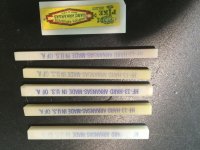After a Pistolsmith learns the ins and outs of the handguns chosen to work with......what he is selling after that is his learned experience and TIME! Tools are tools no matter if it is a vile, nasty old power tool or the finest cut Jeweler's File or the best Arkansas Black Stone. All tools must be mastered in technique and no one should jump right in on say a Registered Magnum for a innards polishing action job using a Dremel for the first time ever. But, given a few years experience with a Dremel or the Foredom Tool (a Dremel on steroids) and the knowledge which surfaces are safe to be altered with the Dremel/Foredom tool and which are not, then the action job on the above Registered Magnum could very well be done in half the time by the proper use of those power tools.
An aside: I had a very good customer that just couldn't believe that he couldn't improve any handgun with the use of his Dremel. After I fixed his third mistake during his 'building' of his very first M 1911, I told him the charge was for him to bring me his Dremel and to never purchase another. Darned if he didn't do just that.
Now, the issue of taking off the ridges on the face of many S&W triggers..........I will polish one out to look just like a S&W original smooth face combat trigger in 1/2 to 1/3 the time someone else would take using files and sandpaper. But, I know how to use the Foredom Tool and I know its limitations. Start with a round grinder in the tool that is about 3/4" in diameter. Mount the trigger securely in a vise where your strong forearm is comfortable at 90 deg. to the trigger. Start grinding in the curve with light even strokes from top to near the tip, but do not run out past the tip. You do and the tool will grab and skitter back across the back of the trigger and you do not want to touch the back of the trigger with any tool during this process. My main vise is mounted at the corner end of my workbench so it is comfortable to work on both sides of the trigger as required. When the ridges are just barely ground away take a critical look at the trigger shape you have created. Re shape as required using very light strokes and a slow rotating speed. Satisfied? Now, put the Dremel/Foredom tool away and proceed with strips of sand paper cut in strips about 1/2" wide. Use the 'shoeshine' motion to sand with increasingly finer strips of sandpaper. When I'm down to about 350 or 400 grit I will switch to 3M's Scotch Brite also cut into 1/2" strips. Usually the finer grade is all that is required. Some shooters prefer the feel of a slightly textured surface on their trigger .....the rougher Scotch Brite can be use in that case. When I have the surface that is required I touch up the tip of the trigger with a piece of fine sandpaper backed by a fine graded file. ............30 minutes Tops!
Now, how to obtain the feel and experience it takes to use your Dremel/Foredom in such a job? Nothing else works as good as buying a couple of junk triggers and working on them first. No one starts in on a procedure requiring fine motor muscle skills and does it perfectly the first time. A little effort in learning the muscle memory required will pay off handsomely for any of us. .............

